英语毕业论文 文化差异在中英肢体语言交际中的影响
- 格式:doc
- 大小:107.00 KB
- 文档页数:18
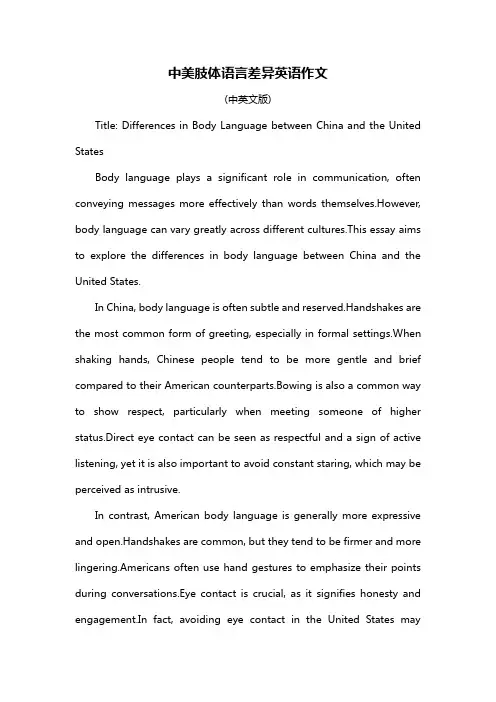
中美肢体语言差异英语作文(中英文版)Title: Differences in Body Language between China and the United StatesBody language plays a significant role in communication, often conveying messages more effectively than words themselves.However, body language can vary greatly across different cultures.This essay aims to explore the differences in body language between China and the United States.In China, body language is often subtle and reserved.Handshakes are the most common form of greeting, especially in formal settings.When shaking hands, Chinese people tend to be more gentle and brief compared to their American counterparts.Bowing is also a common way to show respect, particularly when meeting someone of higher status.Direct eye contact can be seen as respectful and a sign of active listening, yet it is also important to avoid constant staring, which may be perceived as intrusive.In contrast, American body language is generally more expressive and open.Handshakes are common, but they tend to be firmer and more lingering.Americans often use hand gestures to emphasize their points during conversations.Eye contact is crucial, as it signifies honesty and engagement.In fact, avoiding eye contact in the United States maysuggest that a person is untruthful or disinterested.Personal space is another area where differences are evident.In China, people are accustomed to being in closer proximity to one another, and therefore, they may invade personal space without realizing it.Americans, on the other hand, value their personal space and may feel uncomfortable if someone stands too close.Body language during conversations also varies between the two cultures.In China, nodding and indirect head movements are common ways to show agreement or understanding.Silence is not necessarily seen as awkward and can be a sign of contemplation.In the United States, however, people tend to be more verbose and may view long periods of silence as a sign of discomfort or disinterest.In conclusion, the differences in body language between China and the United States reflect the cultural nuances of each society.Understanding these variations can help individuals communicate more effectively and avoid misunderstandings when interacting with people from different cultural backgrounds.标题:中美肢体语言差异肢体语言在交流中起着重要的作用,它往往比言语本身更能有效地传达信息。
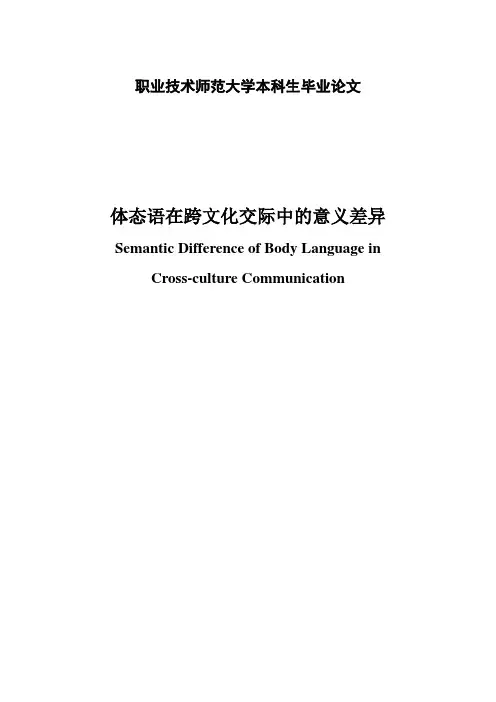
职业技术师范大学本科生毕业论文体态语在跨文化交际中的意义差异Semantic Difference of Body Language in Cross-culture CommunicationStatement of OriginalityI declare that the work presented in this thesis is to the best of my knowledge and belief, original except as acknowledged in the text, and that the material has not been submitted in whole or part for a degree at this or any other university.________________ (Signature)Abstract in English (ii)Abstract in Chinese (iii)I. Introduction (1)II.Functions and Characteristics of Body Language (2)2.1 Functions of Body Language (2)2.2 Characteristics of Body Language (3)III.Types of Body Language (3)3.1 Distance between conversationalists (4)3.2 Facial expression (5)3.3 Eye contact (6)3.4 Physical contact (7)3.4.1 Handshake (7)3.4.2 Hug and kiss (7)3.5 Gesture (7)IV.The Relationship between Body Language and Culture (8)4.1 Cultural influence on body language (8)4.2 Comparison of Chinese Culture and American Culture (10)4.2.1The core factors of Chinese culture (10)4.2.2The core factors of American culture (11)4.3 Comparison of body language in Chinese and American Culture (11)4.3.1 Posture (12)4.3.2 Gesture (12)4.3.3 Touch (13)4.3.4 Eye contact (14)4.3.5 Facial expression (15)V. Conclusion (16)Notes (18)Bibliography (19)Acknowledgments (20)The fast development of science, technology and economy brings about more international contact and exchanges. The communication between people from different cultures and countries is also increasing, not only of language communication but also of nonverbal communication. People often express the thoughts with body language for more sooth communication. Body language is strongly connected with the culture and it plays a very important role in nonverbal communication. In intercultural communication, the same body language may mean different things. Under the different cultural backgrounds, the significance of the body language is not the same. In order to avoid misunderstandings in cross-cultural communication, we should know the body language of each culture. This paper deals with exploring the similarities and differences of body language from different cultures, especially through comparing of Chinese body language and American body language, from which we can know the cultural differences better and avoid misunderstanding and embarrassment in cross-culture communication.Key words: nonverbal communication;body language;cross-culture communication摘要随着科学技术和经济的快速发展,人们有了越来越多的机会能和来自不同背景的人沟通和交流。
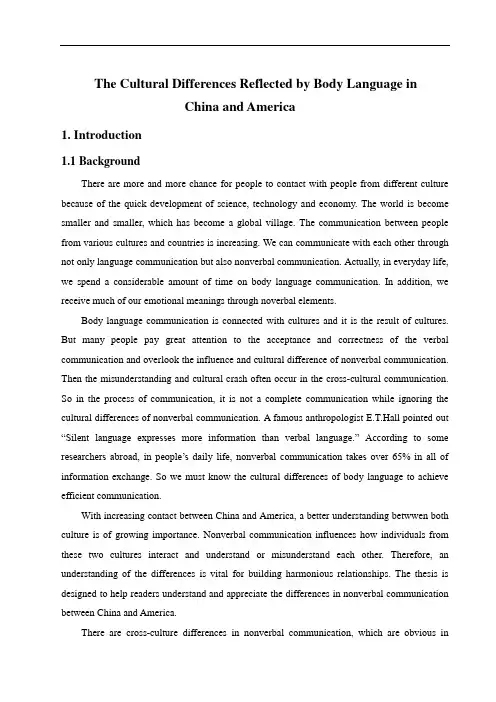
The Cultural Differences Reflected by Body Language inChina and America1. Introduction1.1 BackgroundThere are more and more chance for people to contact with people from different culture because of the quick development of science, technology and economy. The world is become smaller and smaller, which has become a global village. The communication between people from various cultures and countries is increasing. We can communicate with each other through not only language communication but also nonverbal communication. Actually, in everyday life, we spend a considerable amount of time on body language communication. In addition, we receive much of our emotional meanings through noverbal elements.Body language communication is connected with cultures and it is the result of cultures. But many people pay great attention to the acceptance and correctness of the verbal communication and overlook the influence and cultural difference of nonverbal communication. Then the misunderstanding and cultural crash often occur in the cross-cultural communication. So in the process of communication, it is not a complete communication while ignoring the cultural differences of nonverbal communication. A famous anthropologist E.T.Hall pointed out “Silent language expresses more information than verbal language.” According to some researchers abroad, in people’s daily life, nonverbal communication takes over 65% in all of information exchange. So we must know the cultural differences of body language to achieve efficient communication.With increasing contact between China and America, a better understanding betwwen both culture is of growing importance. Nonverbal communication influences how individuals from these two cultures interact and understand or misunderstand each other. Therefore, an understanding of the differences is vital for building harmonious relationships. The thesis is designed to help readers understand and appreciate the differences in nonverbal communication between China and America.There are cross-culture differences in nonverbal communication, which are obvious inmany aspects. Gestural symbols play a large part, and because this is true, gestural emblems are highly sensitive. The same body language have different interpretation because of different cultures. Different body language can be used in different background, however, they can express the same siginificance.To master the nonverbal communication is a necessary part for those who come from different culture. Some people find it difficult to understand the nonverbal code. Because they do not know the background of body language.1.2 SignificanceBody language communication is very important in people communication because it can help us cause first impressions. Think for a while we often judge a person coming from nonverbal information, especially body language. It is important many original information usually can have intuitive recognition. Even how we choose a partner is based on the people who give us the first impression. For example, a famous Chinese proverb going on “fall in love at first sight.” Whether we can have a long-term association with other person also based on the first impression.Body language is so important that some people think of body language as equal to nonverbal communication. More and more people realize the importance of body language communication. We can know more about people’s instinctive feelings situation grounded on their behavioral communication. For example, when we notice a person closing finger tightly with stern appearance, we can judge that this person is sad based on his action. When we are hearing people with shaking sound and noticing them with quivering hands, we can judge that this person is mentally troubled regardless of their saying. Our feelings are showed in our gesture, posture, facial expression and eye contact-it can be happy, sad, anxious and anger and so on. Therefore, we can show our attitude and express ourselves without speaking anything. Because of this, we depend largely on what we have learned coming from our eyes. Many researcher make know that we will rely heavily on non verbal communication rather than verbal ones when they are in conflict with each other.When we come to realize that the nonverbal communication is very important, it is apparent that nonverbal behavior can communicate(convey)people’s physical as well asmental situation. The importance of nonverbal behavior is apparent if we realize that in one form or another, all of our actions convey information about our psychological and physical states. A stroking of the the chin, bow, wave, pointed finger, or yawn all have a message. Our actions, in addition of those association with some illness, have some rules; in a particular way, they stand for outsider speaking to insider. And it is very significant, those behaviors show the time, be it turning to face in another direction from people with whom we feel uneasy. It is very important for us to expain correctly behavioral communication of people who come from other cultures.It is well know that some nonverbal actions have close connection with culture. The body language may lead to understand incorrectly for people of different behaviors who send the same message with different gestures of the body. Misunderstanding can cause the feeling of offence, insult. From these reason, I think that it is highly necessary to make cross-cultural studies of the body language.2 Definition and functions of body language2.1 Definition of body languageBody language, also called body movements, body behavior and so on, refers to all expressions and movements that send communicative messages. Body language is a process in which communicators use the natural features of their bodies to deliver information and express specific meaning instinctively to the other communicator. We will discuss it in details later. It used by people for sending messages to one another. It is very useful because it can help you make yourself easily understood.Different scholars have made various efforts to define it. Accoring to Knapp the phrase‘nonverbal communication’ reffered to communication effect by means other than words. Some linguist also claimed that body language could be without the use of words. Other linguists took into account social cinventions in defining body language. Besides social conventions, many oter factors are also important in helping convey nonverbal meanings. The meanings of body language often have to be interpreted via considerations of such aspects, because these factors may help make clear the complexity of bodylanguage.However, these factors are so diliverse and complex that a perfect definition is impossible. It is so natural that current definitions are different from the ones in their orientations.2.2 Functions of body languageBody language like verbal communication is also a part of culture and the carrier of a certain culture. The function of body language in the whole communication can’t be overlooked. “In the daily communication, we can see people can’t communicate effi ciently by verbal language alone. And nonverbal communication will express clear meanings in a certain context. And a certain nonverbal communication should be connected with verbal communication or the other nonverbal communication to provide correct info rmation.” So in communicative activities, body language also plays a great role. Of course, we should pay close attention to the functions of body language. “In any case, when verbal communication conflicts with no nverbal communication, people are willing to accept the information nonverbal communication delivers. Because nonverbal communication sounds more natural, more instinctive and it is hard to pretend.”Obviously, we should make full use of body language to achieve efficientcommunication. Now, we will discuss the functions of body language.Nonverbal communication ofen performs one of several functions in relationship to verbal communication. These functions help us to understand and use communication more effectively. Nonverbal messages serve six major functions: repetition, contradiction, substitution, accentuation, supplementation or modification and regulation.Repetition is defined as the process of reinforcingverbal messages through redundancy. People often use nonverbal messages to repeat apoint they are trying to make. For example, when we tell people how to get to the nearest hospital, we are not only telling them the direction but also pointing to the direction with hands. Generally speaking, the gestures and words have a similar meaning and reinforce one another.Contradiction is the opposite of repetition; it negates the verbal message. On some occasions, our nonverbal actions send signals opposite from the literal messages contained in our verbal messages. For instance, you tell someone you are relaxed and at ease, yet your voice quavers and your hands shake.Substitution. We use substitution in body language when we perform some action instead of speaking. If a group of people is boisterous, you might place your index finger to your lips as an alternative to saying “please calm down so that I can speak”.Accentuation. For example, you may have noticed how some people tap the desktop with each word of an important message like “I want you to do this today”.Supplement. For instance, we greet people with a smile. Smile functions as a supplement to the pleasure of meeting people.Regulation occurs when nonverbal messages help to control the flow of verbal messages. We often regulate and manage communication by using certainform of body language. We nod our head in agreement to indicate to our communication partner that we agree and that he or she should continue talking or we have direct eye contact with someone to let him or her know the channels are open.Thus,body language function sometimes occur separately, and sometimes they occur at the same moment. Without them, we should have a very difficult time communicating.3 Cultural differences of body language betwwen Chinese and Americans3.1 Types and differences of body languageHere, we research into three elements of body language: gesture (head gesture, facial expressions, eye contact, arm gesture, hand gesture, and leg movement), posture(walking posture, standing posture, squatting posture, and sitting posture), and touch (ten distinctions concerning touching behaviors) Different believes are the causes of the differences of body language. According to the theories proposed by American anthologists Barnettt Pearce, Verrion Cronent, people’s behavior, the way of thinking and so on are aff ected by their believes. And every culture has its distinctive belief system. A normal action in this culture will be abnormal in another one. A positive behavior in one culture will be negative in another. People from eastern world advocate modesty, tolerance, mutual-support and responsibility for the group. But western people admire independence, self-respect, free development, and requiring individual space and so on. Next, we will go to the differences of body language from five parts.3.1.1 Head gestureChinese and American head gesture shares a number of similarities. For example: nodding the head up and down means “yes”, “I agree”; shaking the head side to side means “no”; heading forward shows an interest in the conversation; heding backward shows lack of interest and so on.As to the differences, a nod of the head in China can function as greeting and beckoning someone to come here, while the same function performed by the Americans is a raise of the head. Patting on head means differently in these two cultures. Occasionally, Chinese adults may pat the head of children to show affection; patting the head of a teenager or an adult would cause displeasure and can be insulting. Americans’ patting on other’s head is just for giving comfort, consolation or encouragement; and also for showing affection.A unique head gesture in China-tip the head backward and audibly suck air in through the teeth-meas “no”or “something is very difficult” and has the function of pausing to rethink. Also there are some head gestures use in America but seldom seen in China: scratching the head means thinking or confused or skeptical; chin stroke, tapping the head with forefinger showscontemplation; hand cutting across the top of the head shows impatience; head switching to one side with a rush or chin pointing to a certain direction function as beckoning someone to come here or pointing direction.3.1.2 Facial expressionsWe constantly read expressions from people’s face. In fact, facial cues are the single most important source of nonverbal communication.Facial expressions have some own features: they are innate and universal. Therefore, the expressions for happiness, sadness, disgust, fear, anger, and surprise (the six basic emotions) are recognized by most culture groups as having the same meaning. However, some variations also exist. Some facial expressions and their interpretations may vary from one culture to another.Generally speaking, Chinese people are more self-controlled, especially in formal, public occasions, and when communicate with strangers and foreigners, they tend to control their emotions. When in down spirits (sad, angry, contemptuous and so on), Chinese people usually try to sustain a neutral expression. The whole face is on a loose state, forehead and eyebrow are equable, lips close naturally, and eyes open looking forward-such kind of looks is considered to be a neutral expression. Differently, the Americans may show in their expressions immediately when they are in the same spirits. Controlling one’s bad mood properly is considered mature and well-educated in China. Therefore , they think the Americans’ lack of control their emotions as an illustration of puerility and philistinism; whereas the Americans may consider the Chinese to be wooden and slow.When expressing some positive emotions, such as compliment and sympathy, Chinese people sometimes have less sense of propriety in their exprssions than the Americans do. They think the more exaggerated the better. American people regard this as dishonest.In daily communication and daily behaviors, some differences cause by Chinese’s humility and Americans’ self-esteem are worth mentioning. When receiving honest praise from others, Chinese people usually send an expression showing “I don’t believe”, “no”, “I don’t deserve such praise”, and sometimes even give an anxious looks. American people think that such response is dishonest and hypocritical. On the contrary, they may smile to the person who praise them, accept the compliment and usually say “thank you”. In the Chinese point of view, such response is kind of pride and conceited.3.1.3 Smile and laughterWhen it comes to smile and laughter, the most common facial expressions, they may cause some misunderstandings between Chinese and American culture. Thus it is necessary to explore them further in this point. Smile and laughter usually convey friendliness, approval, satisfaction, pleasure, joy, merriment. This is generally true in China as well as in America. However, it may be difficult for Americans to believe that smiling for the Chinese not only means that someone is happy, but also that he or she is sorry. It is desirable for a Chinese to apologize with a smile, which indicates humbleness and embarrassment.3.1.4 Eye languageAs saying go es “The eyes are the window of the soul”. That is to say, we can read one’s mind through his or her eyes. Eye language can express complicated feelings and it is an important way to judge the intimacy of communicators. People from America have more eye contact than Chinese people when they are in conversation. According to American tradition, communicators must gaze at each other. “But there are many rules about eye language: Whether to look at the other communicator or not; when it is the time to look at them, how long we can look at; who we can look at and who we can’t; they all imply different meanings in communication.”Americans pay great attention to the time and the way of eye contact. In common conversation, they will look at each other about one minute and then they will look away. If two Americans gaze at each other, which indicate they are intimate. In North America, the children there have learned to look at the other communicator directly. If they don’t, they are regarded lack of enthusiasm or co nfidence. They believe the saying “Never trust a person who can’t look you in the eyes.” For showing politeness or respect, Chinese people frequently avoid direct eye contact with others.3.2 Gestures“Gesture means we communicate and express by the movement and manners of our hands and fingers.” In our daily li fe, every one makes gestures, but many gestures have distinct regional and cultural features. “Don’t assume that every one in the world understands one gesture in the same way.”For example, A mericans often touch their temples to express somebody’s cleverness. But。

中西方肢体语言的差异英语作文英文回答:Body language plays a crucial role in communication, conveying messages that words may not. However, cultural differences can lead to significant variations in the interpretation of body language, resulting in misunderstandings and even conflict. This essay will delve into the key differences between body language in Western and Eastern cultures.Eye Contact: In Western cultures, direct eye contact is generally considered a sign of sincerity, confidence, and trustworthiness. Maintaining eye contact while speaking indicates that you are engaged and attentive. However, in some Eastern cultures, prolonged eye contact can be perceived as aggressive or disrespectful. For example, in Japan, it is customary to avert one's gaze to show deference.Proximity: In Western cultures, there is a greater emphasis on personal space, and people tend to maintain a larger distance between themselves and others during conversations. Conversely, in many Eastern cultures, closer proximity is a sign of warmth and intimacy. For instance, in China, it is common to stand closer together and engage in more physical touch.Gestures: Gestures can convey a wide range of emotions and messages. However, the meaning of gestures can vary significantly across cultures. For example, the "thumbs up" gesture, which indicates approval in Western cultures, can be perceived as offensive in some Middle Eastern countries. Similarly, the "OK" sign, which represents agreement in the West, can be interpreted as an insult in Brazil.Body Posture: Body posture can communicate both physical and emotional states. In Western cultures, sitting or standing up straight is seen as a sign of confidence and alertness. However, in some Eastern cultures, a more relaxed posture may be considered more polite and respectful. For instance, in Thailand, it is considereddisrespectful to sit in a cross-legged position in front of an elder.Facial Expressions: Facial expressions are universal to some extent, but their interpretation can differ across cultures. For example, in Western cultures, smiling is generally associated with happiness and joy. However, in some Eastern cultures, smiling can also indicate discomfort or embarrassment. Similarly, the expression of anger may be more restrained in Eastern cultures, while it is more openly expressed in Western cultures.Cultural Context: It is important to note that body language should always be interpreted within its cultural context. What may be considered appropriate in one culture may be considered rude or disrespectful in another. For example, in Western cultures, it is common to shake hands as a greeting. However, in some Eastern cultures, it is more customary to bow or make a slight nod as a sign of respect.Understanding the cultural differences in body languagecan help avoid misinterpretations and facilitate effective communication. By being aware of these variations, individuals can adapt their nonverbal cues to the specific cultural context they are in, fostering betterintercultural connections and avoiding potential misunderstandings.中文回答:肢体语言在交流中起着至关重要的作用,它传达着言语无法表达的信息。
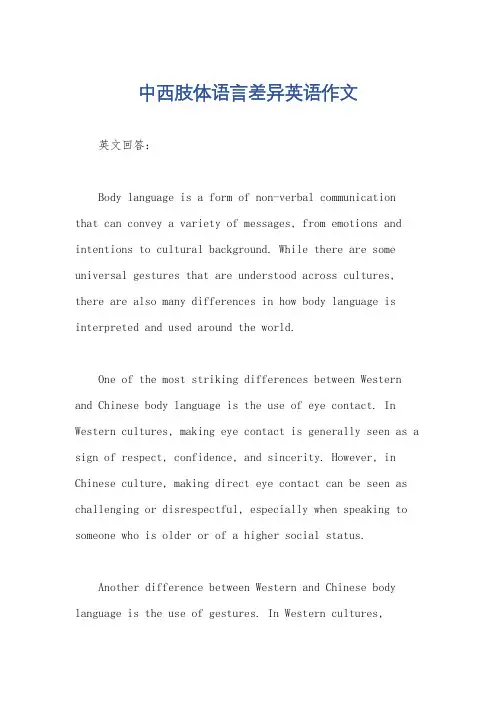
中西肢体语言差异英语作文英文回答:Body language is a form of non-verbal communicationthat can convey a variety of messages, from emotions and intentions to cultural background. While there are some universal gestures that are understood across cultures, there are also many differences in how body language is interpreted and used around the world.One of the most striking differences between Western and Chinese body language is the use of eye contact. In Western cultures, making eye contact is generally seen as a sign of respect, confidence, and sincerity. However, in Chinese culture, making direct eye contact can be seen as challenging or disrespectful, especially when speaking to someone who is older or of a higher social status.Another difference between Western and Chinese body language is the use of gestures. In Western cultures,people often use gestures to emphasize their words or to convey emotions. However, in Chinese culture, gestures are often more subtle and reserved. For example, while Westerners might use a thumbs-up gesture to indicate approval, Chinese people might use a nod of the head or a slight smile.The use of personal space is also different between Western and Chinese cultures. In Western cultures, people tend to value personal space and may feel uncomfortable if someone stands too close. However, in Chinese culture, people are more accustomed to close physical contact and may not be offended if someone stands close to them.These are just a few of the many differences between Western and Chinese body language. By understanding these differences, we can avoid misunderstandings and communicate more effectively with people from different cultures.中文回答:肢体语言是一种非语言沟通形式,可以传递各种信息,从情感和意图到文化背景。

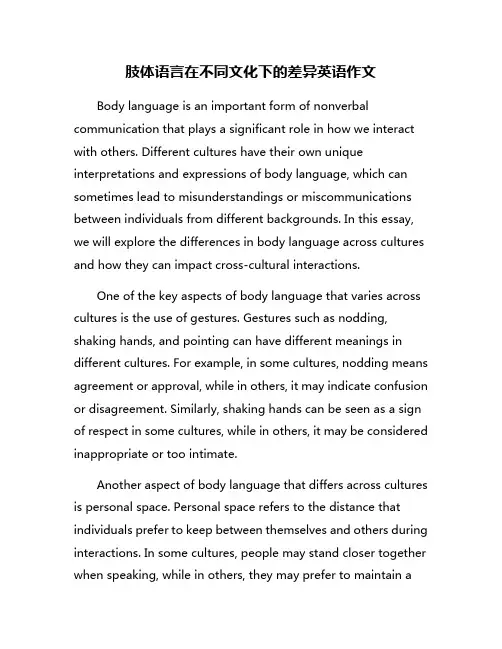
肢体语言在不同文化下的差异英语作文Body language is an important form of nonverbal communication that plays a significant role in how we interact with others. Different cultures have their own unique interpretations and expressions of body language, which can sometimes lead to misunderstandings or miscommunications between individuals from different backgrounds. In this essay, we will explore the differences in body language across cultures and how they can impact cross-cultural interactions.One of the key aspects of body language that varies across cultures is the use of gestures. Gestures such as nodding, shaking hands, and pointing can have different meanings in different cultures. For example, in some cultures, nodding means agreement or approval, while in others, it may indicate confusion or disagreement. Similarly, shaking hands can be seen as a sign of respect in some cultures, while in others, it may be considered inappropriate or too intimate.Another aspect of body language that differs across cultures is personal space. Personal space refers to the distance that individuals prefer to keep between themselves and others during interactions. In some cultures, people may stand closer together when speaking, while in others, they may prefer to maintain agreater distance. This can lead to misunderstandings or discomfort when individuals from different cultures interact, as they may not be aware of or understand the cultural norms regarding personal space.Posture and facial expressions are also important components of body language that can vary across cultures. For example, in some cultures, maintaining eye contact during conversation is seen as a sign of respect and attentiveness, while in others, it may be considered confrontational or rude. Similarly, the way people sit or stand can convey different meanings in different cultures. A relaxed posture may be seen as a sign of confidence or ease in some cultures, while in others, it may be interpreted as laziness or disrespect.In order to navigate these differences in body language across cultures, it is important to be aware of and sensitive to the cultural norms and expectations of the people you are interacting with. In some cases, it may be necessary to adapt your own body language to align with the cultural expectations of the individuals you are communicating with. This can help to establish rapport and build positive relationships with people from different cultural backgrounds.Overall, body language is a powerful form of communication that can both connect and divide us across cultures. By understanding and respecting the differences in body language across cultures, we can foster better cross-cultural understanding and collaboration. Through open-mindedness and empathy, we can bridge the gap created by these differences and build stronger relationships with individuals from all walks of life.。
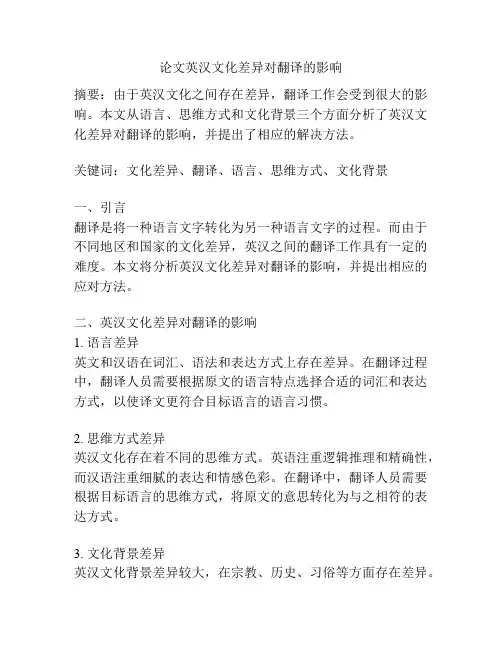
论文英汉文化差异对翻译的影响摘要:由于英汉文化之间存在差异,翻译工作会受到很大的影响。
本文从语言、思维方式和文化背景三个方面分析了英汉文化差异对翻译的影响,并提出了相应的解决方法。
关键词:文化差异、翻译、语言、思维方式、文化背景一、引言翻译是将一种语言文字转化为另一种语言文字的过程。
而由于不同地区和国家的文化差异,英汉之间的翻译工作具有一定的难度。
本文将分析英汉文化差异对翻译的影响,并提出相应的应对方法。
二、英汉文化差异对翻译的影响1. 语言差异英文和汉语在词汇、语法和表达方式上存在差异。
在翻译过程中,翻译人员需要根据原文的语言特点选择合适的词汇和表达方式,以使译文更符合目标语言的语言习惯。
2. 思维方式差异英汉文化存在着不同的思维方式。
英语注重逻辑推理和精确性,而汉语注重细腻的表达和情感色彩。
在翻译中,翻译人员需要根据目标语言的思维方式,将原文的意思转化为与之相符的表达方式。
3. 文化背景差异英汉文化背景差异较大,在宗教、历史、习俗等方面存在差异。
翻译人员在进行翻译时需要对目标语言的文化背景有一定的了解,以便更好地传达原文的意义和文化内涵。
三、解决方法1. 增加语言学习翻译人员需要增加对目标语言的学习,深入了解其词汇、语法和表达方式,以便更好地进行翻译工作。
2. 加强文化研究翻译人员需要深入研究目标语言的文化背景,了解其宗教、历史和习俗等方面的差异,以便更好地传达原文的含义和文化内涵。
3. 灵活运用翻译技巧翻译人员需要根据具体情况,灵活运用翻译技巧,选择合适的词汇和表达方式,以使译文更符合目标语言的语言习惯和文化背景。
四、结论英汉文化差异对翻译具有一定的影响。
翻译人员应增加语言学习,加强文化研究,并灵活运用翻译技巧,以便更好地进行翻译工作。
同时,也需要世界各国的翻译人员加强合作,共同促进跨文化交流。

文化差异对英语交际影响的研究摘要:语言是文化的载体,是否能顺利的进行英语交际反应了学生对西方文化的掌握程度。
中西方文化的差异主要表现在哪些方面?教师如何在教学中向学生输入跨文化交际中应该注意的问题?本文根据笔者多年的中学英语教学体验,结合相关的理论研究,就中西方文化差异的主要方面对中学生英语交际的影响进行粗略的探讨,为促进中学英语教学提供参考。
关键词:中西方文化差异英语跨文化交际近年来,随着改革开放步伐的加快,对外交往日益频繁,国与国之间交流越来越广泛,特别是社会信息化的提高,国际互联网的开通使更多的人足不出户便涉及跨文化交际。
如果人们缺乏对中西方文化差异的了解,在对外交流中就会产生一定的障碍。
因此,我们在文化教学方面不仅要培养学生使用语言的能力,而且要培养学生合适地使用语言进行跨文化交际的能力,进而提高综合素质。
i.正确理解本国文化与西方文化,了解其差异性《英语课程标准》中所说的“文化意识”就是指对社会文化的认识,尤其是对西方文化的认识,他包括文化知识、社会风俗以及跨文化交际意识和能力。
笔者认为,学生在以后的口语交际中可以从以下的几个文化差异方面稍加注意。
一、称呼的差异在汉语中,学生见到老师要问候“老师好”.还有“张医生”、“李经理”等称呼。
而在英语中,人们不说”teacher zhang”,”engineerliu”等。
他们习惯把mr.,mrs.,miss与姓连用表示尊敬或礼貌。
“小张、小李”在汉语里是很亲切的称呼,而用“小杰克”称呼一位英国青年却是不礼貌的;用汉语称呼“孟老、老人家”,中国老人听得心里美滋滋的,可是英美老人如果不了解中国文化,他们可能会很不高兴地反驳“难道我有那么老吗?”二、言谈的差异中国人见面寒暄通常是:“你多大年纪?”“结婚了吗?”。
在中国人眼里,这是一种礼貌,而在英语文化中,年龄、地址、工作单位、收入、婚姻、家庭情况、信仰等话题属个人隐私范畴。
英美人寒暄最频繁的话题是天气的状况或预测。

(20_ _届)英语中英文化差异对英汉翻译的影响A Study of the Application of Polite Talks inHigh School English TeachingAbstract .........III ^Introduction1/1 Background information (1)1.2Purpose of writing (2)2eThe six main cultural factors (2)2.1Ways of thinking (2)2.2Manners and customs (3)2.3Literary quotation (4)2.4Religious tradition (5)2.5Values and ideas of beauty (6)2.6Region environment (7)3.Some other cultural factors (8)Conclusion (9)Bibliography (9)Acknowledgements (10)摘要翻译是把一种语言表达的意义用另一种语言表达山来,以达到沟通思想情感、传播文化知识、促进社会文明,特别是推动译语文化兴旺昌盛的目的(孙致礼,2003)。
翻译一直是国内外专家研究的焦点。
本世纪是屮平文化同世界文化广泛交流、共同繁荣的世纪,也是翻译事业的黄金时代。
然而,语言和文化是一个互为依存、密不可分的整体, 世界上没冇哪一种语言能离丌特定的文化。
任何语言都充满了人类文化活动的痕迹,因此,这种文化上的差异对英汉翻译的影响是不可避免的。
本文立足于文化差昇对英汉翻译的影响,将主要从思维方式、历史典故、风俗习惯、宗教传统、价值观念及审美观念、地域环境等六个方而来分析文化差异对英汉翻译的影响。
关键词:翻译:文化;文化差异;影响AbstractTranslation is a tool that converts one language into another,its purpose is to communicate ideas,transmit culture, promote social civilization,especially to propel the target language culture to be booming and prosperous. As a research topic of much concern, translation has always been discussed by experts from home and abroad. This century is century of a wide exchange and co-prosperity between Chinese culture and the world culture, as well as the golden age of translation cause. However, language and culture is mutually dependent and inseparable, there isn’t any language in the world can separate from a certain culture. All the languages are full of traces of human culture activity. Therefore, these culture differences have an inevitable influence on the English-Chinese translation. This essay focuses on this influence and will analyze it from 6 main aspects like the mode of thinking, literary quotation, social customs and habits, religious tradition, values and aesthetic standards and territorial environment.Key words:translation; culture; cultural difference; influence1 IntroductionBackground informationNowadays science and technology advances swiftly and vigorously. In this age of economic globalization, translation’s role as a bridge between information spreading and communication becomes more and more important. And it was considered as a conversion of two different languages. However,translation is a transform of language character in form, but its true aim is the exchange of different cultures. Translation and culture are closely related,and is always limited and influenced by culture. Every nation has its own culture,this culture is formed in a particular environment, history, geography,and the realities of society, therefore it has the particularity. To master a language should be familiar with the cultural particularity behind it,and look into the differences between native culture and other cultures. Since those differences must affect the English-Chinese translation,it is of significance whether in theory or practice to research the culture differences’ influence on translation.Purpose of writingTranslation is not a mere activity of language,it also involves some non-language characters,especially the cultural elements. The ultimate goal of translation is to exchange cultures and promote social progress. Therefore, the cultural characters play an important role in the translation. Translators should not only have bilingual abilities but also should have the knowledge of two cultures, even several cultures. In 1993, Nida pointed out that,for the truly successful translation, the knowledge of two cultures is more important than the bilingual ability. E.B.Tylor,an anthropologist,thought culture is a complicated gathering, including knowledge,belief,arts, moral standards, law,customs and all the abilities and habits of individuals as members of a society. With the vigorous development of translation career, it is critical to know about the difference between foreign culture and native culture. Recognize native culture, and be well up in the foreign culture can make the process of translation favoring,and present the articles’ essentiality perfectly to the readers. So it is necessary for translators to learn the cultural differences. Otherwise, the version can be stiff and rigid. This essay is aim at researching the culture differences between Chinese and English, and explaining how they affect the English-Chinese translation.2.The six main cultural factors2.1 Ways of thinkingWays of thinking. Western nations are used to adopting abstractness, an analytical mode from one tomany. Their sentences focus on subjects and predicates,and they control phrases and subordinate clauses, from the main to secondary. Though its form comes loose, its meaning holds together. On the contrary,Chinese would prefer to use the concreteness, a synthesizing type mode from many to one. The majorities of sentences take verbs as center,and follow a chronological order with a focus on communal harmony. Sometimes a long English sentence need translating into several short Chinese sentences while some short Chinese sentences can be converted into a long English one. Different thinking modes between Chinese and English countries make them differ in choosing the sentence pattern,diction, words omission...and so on. For example,’’ It had been a fine,golden autumn,a lovely farewell to those who would lose their youth,and some of them their lives, before the leaves turned again in a peacetime fall.” If we translate it directly it can be:那是一个美好的金秋,在古别了那些可能丢失他们的青春S-至.生命的人2后,树叶才慢慢的落下.This kind of version is absolutely limited by linguistic form. As we can see,its structure is shapeless and stiff,and its language is incoherent and fragmented. However, if we make it like this:"那是个天气晴朗,金黄可爱的秋天,美好的秋121为那些青年们送别。

论文:从肢体语言看中西方文化差异Chinese and western cultural differences in body language一.引言二.肢体语言概述(一)肢体语言的概念及特征(二)肢体语言的相关理论三、肢体语言在差异文化中的发展与演变(一)肢体语言在人类社会交流方面的重要性1 不同种类的肢体语言所代表的意思2 肢体语言在交流中的作用以及重要性3 在中西方交流中,怎样恰当的使用肢体语言?(二)社群交流及族群认同性对区域文化历史的形成、发展的重大影响1中西方区域文化的历史的形成和发展对比2 中西方区域交流文化的重大差异(三)区域文化对肢体语言的反作用(四)中西方文化的主要内容和差异1 肢体语言对中西方交流文化的影响2 通过肢体语言对中西方交流文化造成差异的过程以及原因3 中西方交流文化中的肢体语言的比较以及异同四.肢体语言的东西方差异,在经济全球化带动文化交流融合的现代的发展趋势。
1 在中西方交流中学习肢体语言的必要性和重要性2 肢体语言在文化交流中的发展趋势五.结论1 General ideas of body languageA the definition of body languageB the relative theory of body language2 the development and exchange of body language in different culturesA the importance of body language in human ’s communication1. Introduction (1)2. The necessity and importance of learning body language on nonverbal communication (2)3. The concrete types and application of the body language (3)3.1 Types of body language (3)3.1.1 Distance between people conversing (3)3.1.2 Physical contact (3)3.1.3 Eye contact (4)3.1.4 Smiles and laughter (6)3.1.5 Gestures (6)3.2 Application of the body language (6)3.2.1 Greetings (6)3.2.2 Signs of affection (8)3.2.3 Physical contact in life (8)3.3 A comparative study of Chinese and American body language (9)4. Conclusion (12)Introduction1. General ideas of body language 52. ?The different kinds of body language 62.1 Manual speech2.2 face expression2.3 posture expression3. ?The function of body language4.How to use body language5. The importance of body language浅谈非语言交际中的身势语摘要“身势语”同语言一样,都是文化的一部分。
中西方肢体语言的差异英语作文英文回答:Body language is a form of non-verbal communicationthat involves the use of gestures, facial expressions, and body movements to convey messages. It is an essential part of human interaction, as it can help us to express our emotions, thoughts, and intentions.While body language is a universal form of communication, there are some significant differences between the way that it is used in different cultures. For example, in Western cultures, it is considered to be polite to make eye contact with someone when you are speaking to them. However, in some Asian cultures, it is considered to be disrespectful to do so.Another difference between Western and Eastern body language is the way that people use gestures. In Western cultures, gestures are often used to emphasize a point orto convey a specific message. However, in some Eastern cultures, gestures are used more sparingly and are often considered to be more subtle.Finally, there are also differences in the way that people use body language to express emotions. In Western cultures, it is common to express emotions openly and directly. However, in some Eastern cultures, it is considered to be more appropriate to express emotions indirectly or subtly.These are just a few of the many differences between Western and Eastern body language. It is important to be aware of these differences when interacting with people from other cultures, as it can help to avoid misunderstandings and miscommunications.中文回答:肢体语言是一种非语言交流形式,它涉及使用手势、面部表情和身体动作来传达信息。
研究方向:文化作者姓名:所学专业:英语论文题目:On the Taboo differences in Body Language in Chinese and Western cultures浅析肢体语言禁忌在中西文化中的差异论文字数:4,200指导老师:提交日期:2A thesis submitted to the Foreign Languages Department of Northwest University for Nationalities for the degree of Bachelor of ArtsTable of Contents1I n t r o d u c t i o n (1)2T h e S i g n i f i c a n c e a n d F e a t u r e s o f B o d y L a n g u a g e (2)2.1S i g n i f i c a n c e o f B o d y L a n g u a g e (2)2.2T h e F e a t u r e s o f B o d y L a n g u a g e (3)3T a b o o s i n B o d y L a n g u a g e (3)3.1Ta b o o s o f F a c i a l E x p r e s s i o n s (3)3.1.1S m i l i n g (4)3.1.2S m a c k i n g (4)3.1.3C o v e r i n g t h e M o u t h (4)3.2Ta b o o s o f E y e C o n t a c t (4)3.3Ta b o o s o f G e s t u r e (5)3.3.1W a v i n g (5)3.3.2“V”G e s t u r e (6)3.3.3“O K”G e s t u r e (6)3.3.4M i d d l e F i n g e r-u p (6)3.3.5T h u m b s-u p (7)3.3.6S h a k i n g H a n d s (7)3.4Ta b o o s o f P o s t u r e (8)3.4.1S i t t i n g (8)3.4.2C r o u c h i n g (9)3.4.3W a l k i n g (9)3.5Ta b o o s o f To u c h (9)3.5.1To u c h i n g w i t h St r i n g e r s’B o d y (10)3.5.2 To uc h ing with Bo d ie s of t he Same Sex (10)3.5.3To u c h i n g w i t h C h i l d r e n’s B o d y (10)4C o n c l u s i o n (11)5R e f e r e n c e s (12)6A c k n o w l e d g e m e n t s (13)Taboo in Body Language between China and West 【Abstract】The two ways of human communications, the verbal communication and non-verbal communication are complementary to each other and become undivided entirety. Body language is the most normal non-verbal communication in human communication, including facial expression, eye contact, gesture, posture and touch, etc. The same act of body language can be considered as the different signal and information by the people with different cultural background. Once leaving it out, one may outrage others. Therefore, in the inter-culture communication between China and the West, only by acquiring taboos in body language of each other can people avoid culture conflict.【Key words】Non-verbal communication, body language, taboo, intercultural communication【摘要】人类交际有两种形式:语言交际和非语言交际。
中外肢体语言差异英语作文English Answer:Nonverbal communication, which includes body language, gestures, and facial expressions, plays a crucial role in human interaction. However, this communication varies significantly across cultures, leading to potential misunderstandings and misinterpretations.Body Language.Eye Contact: In Western cultures, direct eye contact is often associated with honesty and confidence. In contrast, in some Asian cultures, prolonged eye contact can be perceived as a challenge or disrespect.Proxemics: The use of personal space differs across cultures. Westerners tend to maintain a larger personal bubble, while Middle Eastern and Latin American cultures typically engage in closer physical interactions.Posture: In many European countries, good posture is considered a sign of professionalism and authority. However, in some Asian cultures, a relaxed and non-confrontational posture is preferred.Touch: Touch can be a powerful form of nonverbal communication, but its interpretation varies. In some cultures, hugging and kissing are common greetings, whilein others, they might be considered inappropriate.Gestures.Thumbs-Up: This gesture, which signifies approval in Western cultures, can be offensive in some Middle Eastern and African societies.OK Sign: The use of the "OK" sign, formed by touching the thumb and forefinger into a circle, is acceptable in Western cultures but has negative connotations in Braziland some Mediterranean countries.The "V" Sign: In most English-speaking countries, the "V" sign symbolizes victory. However, in some Asian cultures, it can be interpreted as a number two or a peace sign.Facial Expressions.Smiling: Smiling is universally recognized as a sign of happiness and friendliness. However, the frequency and context of smiling differ across cultures.Frowning: In Western cultures, frowning usually conveys sadness or disapproval. In some East Asian countries, however, it can also indicate concentration or contemplation.Raised Eyebrows: Raised eyebrows may signify surprise or skepticism in Western cultures. In some Eastern European countries, they can indicate disapproval or judgment.Cultural Sensitivity.To avoid miscommunication and build effective relationships, it is crucial to be aware of cultural differences in body language. By observing, interpreting, and adapting our nonverbal cues to the specific cultural context, we can enhance cross-cultural communication and understanding.Chinese Answer:肢体语言是人类交流中至关重要的一部分,它包括身体语言、手势和面部表情。
中西方肢体语言的差异英语作文English: In both Western and Chinese cultures, body language plays a significant role in communication. However, there are some distinct differences in how each culture interprets and uses body language. For example, in Western culture, eye contact is viewed as a sign of confidence, attentiveness, and sincerity. On the other hand, in Chinese culture, prolonged eye contact can be seen as disrespectful or confrontational. Additionally, gestures such as pointing or using the index finger to beckon someone are common in Western culture but considered impolite in Chinese culture. Furthermore, the use of personal space varies between the two cultures, with Westerners typically requiring more personal space compared to Chinese individuals. Understanding these differences is crucial when interacting with individuals from different cultural backgrounds to avoid miscommunication and misunderstanding.Translated content: 在西方和中国文化中,肢体语言在交流中起着重要作用。
跨文化交际中的肢体语言On Body Language in Intercultural Communication摘要:肢体语言与学外语一样,都是文化的一部分。
除一些世界公认的肢体语言外,不同的文化还有各自的肢体语言。
跨文化交际时,相同的肢体语言形式可能具有完全不同的意义。
本文简单对比中美肢体语言的差别,并介绍了一些国外常用的肢体语言,以此来说明在学习外语的同时,多了解一些国外常用的肢体语言是会有帮助作用的。
关键词:肢体语言;跨文化交际;外语学习Abstract :Body language,like verbal language, is also a part of culture .Different culture shave different body languages except some world known ones. And in intercultural communication, the same body language may mean different things. This paper,on the basis of some examples,emphasizes the significance of body languages in intercultural communication by comparing the body languages in the United States and China, and briefly introducing some body languages often used in foreign countries. The author reaches the conclusion that while learning foreign languages, it is also important as well to know some body languages in foreign countries.Key words: body language; intercultural communication; foreign languages earning肢体语言(body language)也称体态语言,是人类借助和利用自己的面部表情、手势动作、身体姿态的变化来表达和传递思想感情的方式。
中外肢体语言差异英语作文英文回答:In terms of body language, there are definitely some differences between Chinese and Western cultures. For example, in Western countries, making direct eye contact is seen as a sign of confidence and honesty. However, in China, prolonged eye contact can be seen as rude or aggressive.Another difference is in hand gestures. In the West, using your index finger to point at someone or something is common and considered normal. But in China, it's considered impolite to point directly at someone with your finger. Instead, people use an open hand gesture to indicate direction or location.Furthermore, the way people stand or sit can also vary between cultures. In Western cultures, it's common to stand with your hands in your pockets or cross your arms, which can be seen as a sign of confidence or relaxation. However,in Chinese culture, crossing your arms can be seen as defensive or closed off.Overall, understanding these cultural differences in body language is crucial for effective communication and building relationships with people from different backgrounds.中文回答:在肢体语言方面,中西方文化之间确实存在一些差异。
On Cultural Differences of Body Language Between English and ChineseWritten by:Supervised by:English DepartmentCollege of Foreign LanguagesAnhui Normal UniversityOctober 2015AbstractBody language is an important part of nonverbal communication is closely connected with culture. In order to make successful exchange in cross-cultural communication, we should know body language from different cultures. B ody language from different cultures has many differences because of different regions, races and cultural customs. And it is restricted by its culture and has different cultural connotations. That is to say, the same body language has different meanings in different cultures and has different social functions. Take nodding the head as an example, we know it means “yes” among Chinese and many English-speaking countries. But to some Indians, it means “no”. This article devotes to a comparison and contrast of body language in different cultures in terms of eye language, gestures, postures, facial expressions, touch, and distance. It aims to illustrate the differences of body language between Chinese and English cultures, and to put forward the principles of reducing barriers in communication so as to achieve efficient communication and to avoid misunderstanding.Key Words: intercultural communication, body language, cultural differences, principlesI摘要身势语是非语言交际的重要组成部分,和文化紧密相关。
为了在跨文化交际中能够成功地进行交流,我们应该了解不同文化的身势语。
语言和文化一样,由于地域、种族、习俗的差异,不同文化的身势语有许多差异。
它们由文化制约并拥有独特的文化内涵。
也就是说,同样的身势语在不同文化背景下有不同的含义,行使着不同的社会功能。
例如,点头在中西方都表示赞同的意思。
但是在印度,点头却表示不赞同。
本文致力于从目光语、手势语、身体姿态、面部表情、体触语、体距语等方面对不同文化的身势语进行对,旨在通过列举中西方身势语的文化差异,提出交际中遵循的原则,从而促进有效交流,避免误解。
关键词: 跨文化交际,身势语,文化差异,原则IIContents Abstract (I)摘要 (II)I Introduction (1)II Definition, Functions and Importance of Body language (1)2.1 Definition of b ody language (1)2.2 Importance of body l anguage (1)2.3 Functions of nonverbal c ommunication (2)2.3.1 E xchange ideas (3)2.3.2 Complements and substitutes (3)2.3.3 C onvey sentiment (4)2.3.4 S how people’s psychology and character (4)2.3.5 D enote social relations (4)III Characteristics of Body Languag e (6)3.1 Synonymy (6)3.2 Obscurity (6)3.3 Cultural differences (6)IV Reasons for Different Body Languages Between the West and China (7)4.1 Different traditional cultures (7)4.2 Different ethnic t raits.............................................................. (7)4.3 Different social customs (7)V Use of Body Language in Communication (9)5.1 Different exertions between Chinese and the West (9)5.1.1 Postures (9)5.1.2 Gestures (9)5.1.3 Facial expressions (10)5.1.4 Eye c ontact (10)5.1.5Touch (10)5.1.6 Distance (11)5.2 Counter-measures (11)VI Conclusion (13)Bibliography (14)I IntroductionPeople can communicate with each other through not only verbal communication but also nonverbal communication. Moreover, the latter plays an essential role in human communication. Nonverbal communication is connected with cultures and it is the result of cultures. But many people pay great attention to the acceptance and correctness of the verbal communication and overlook the influence and cultural difference of nonverbal communication. The n the misunderstanding and cultural crash often occur in the cross-cultural communication. So in the process of communication, it is not a complete communication while ignoring the cultural differences of nonverbal comm unication. A famous anthropologist Ethel pointed out “Silent language expresses more information than verbal language. Because it contains much information.” According to some researchers abroad, in people’s daily life, nonverbal communication takes part over 65% in all of information exchange. And body language is an important part of nonverbal communication. Many experts have shown the importance of body language in the cross-cultural communication. “A psychologist proposed a formula: the total impact of message = 7% verbal + 38% vocal +55% facial expressions and behavior.” It is clear without body language we can’t finish our informational exchange. Body language, like verbal language can express emotions, exchange ideas and deliver information. So we must know the cultural differences of body language to achieve efficient communication.II Definition, Functions and Importance of Body language2.1 Definition of Body languageBody language is not a language in the strict sense of the word “language”. “Body language” is expressing how one feels by one’s sitting, standing, moving, etc, rather by words (Oxford Advanced Learners English-Chinese Dictionary, 1997). It is a way that we use the natural features of their bodies to deliver information and express specific meaning instinctively to the other communicator.2. 2 Importance of Body LanguageBody language is important in human interaction .It can be reflected by the countless times in a single day that we send and receive body language messages when in presence of other people .Body language is particularly important to the study of intercultural communication because a great deal of body behavior speaks a universal language whether in Dayton, Madrid, Spain or Guangdong china people tend to have a similar meanings for behaviors such as smiling ,frowning ,laughing ,crying.Barn laud highlights some of the reasons why the form of body language is important to the study of intercultural communication: Many and sometimes most of the critical meanings generated in human encounter are elicited by touch, glance, vocal nuance, gestures or facial expression with or without the aid of words. Consciously or unconsciously, intentionally or unintentionally, we make important judgment and descions, send message concerning the internal states of others_ states, they often express without words. For example ,The first time you move from holding hands with your partner to touching his or her face ,you are sending a message and that message takes on added significance if you touch is returned.Body language is also significant because we use the actions of others to learn their effective or emotional states .If we see someone with a clenched fist and a bowing, we do not need words to tell us that this person is angry: If we hear someone‘s voice quarter and see his or her hands tremble, we know that the person is fearful or anxious. Body language is important because we usually show our body language unconsciously; this means that they are relatively freed from distortions .It difficult to control a clenched jaw when we are angry.There exist a true thing that at beginning , human ancestors rely on all sorts of gestures and postures for mutual coordination and communication then developed into verbal communication .So body language is actually the most primitive instrument of communication, non _verbal communication come into being earlier than verbal communication, it is the organ and base of verbal communication, body language is the earliest communication tool of human. 2006zk09022.3 Functions of Nonverbal CommunicationBody language , is a part of culture and the carrier of a certain culture. The function of bodylanguage in the whole communication can’t be overlooked. “In the daily communication, we can see people can’t communicate efficiently by verbal language alone. And nonverbal communication will express clear meanings in a certain context. And a certain nonverbal communication should be connected with verbal communication or the other nonverbal communication to provide correct information.” So in communicative activities, nonverbal communication also plays a great role. Of course, we should pay close attention to the functions of nonverbal communication. “In any case, when verbal communication conflicts with nonverbal communication, people are willing to accept the information nonverbal communication delivers. Because nonverbal communication sounds more natural, more instinctive and it is hard to pretend.” Obviously, we should make full use of nonverbal communication to achieve efficient communication. Now, we will discuss the functions of nonverbal communication, body language.2.3.1 Exchange ideasTo exchange ideas is the most basic function of body language .In daily verbal communication ,people often use body language to match with the verbal language to express what they are trying to make .speakers consciously or unconsciously use body language to express ideas .For example ,we actually use the word ”stop” that signifies a person to stop and might hold up our hand in the gesture at the same time ,or we might point in a certain direction after we just said “The new library is north of that playground ”.The gestures and words have a similar meaning and reinforce one another .Sometimes body language even can express ideas directly ,especially at the kind of occasion that is inappropriate to speak or somebody doesn’t want to speak .For example ,at the place where is as quite as the reading room ,it is inappropriate for people to talk at that time body language is useful.2.3.2 Complement and substitutesAlthough messages that show can stand alone generally complementing adds more information to massagers . You can accent you anger by speaking in a voice that is much louder than one you use in normal conversation .You can tell someone that you are pleased with his or he performance. But if you pat the person on the shoulder at the same time this messages take on extra meaning. Body language can even substitute the words .If you see a very special friend ,you are apt to enlarge the size of your smile and throw open arms to greet him or her which is a substitute for all the words you want to convey the same feeling I miss” you very much“ .And we can also regulate our communication by using some form of body language .a smile and an outstretched hand show welcome .a frown is a sign of displeasure .Nodding one’s head means agreement _”Yes ”.Waving an。